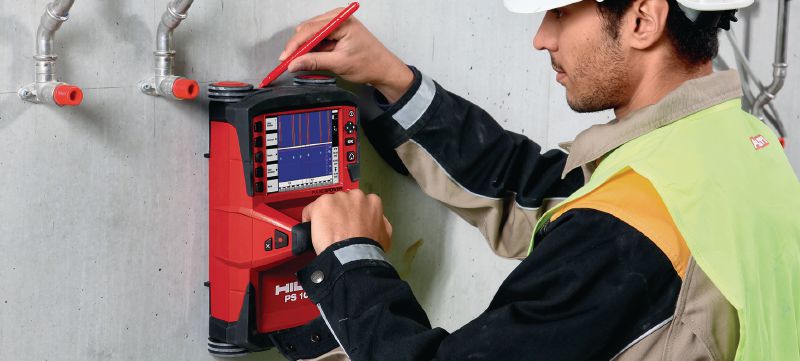Discovering the Depths: A Comprehensive Overview to Concrete Scanning and Its Diverse Applications
In the realm of construction and facilities development, the precise procedure of concrete scanning holds a crucial duty in guaranteeing the architectural stability and safety of tasks. As technology proceeds to progress, the applications of concrete scanning have expanded much beyond simple surface-level assessments.
Value of Concrete Scanning
Comprehending the importance of concrete scanning is critical in making certain the safety and honesty of structures during building and construction and restoration projects. Concrete scanning uses advanced innovations such as ground-penetrating radar (GPR) and electromagnetic induction to identify ingrained things, voids, or various other abnormalities within concrete frameworks.
Furthermore, concrete scanning plays an essential function in making certain compliance with building regulations and guidelines that mandate the security of existing structural components throughout construction tasks. By precisely mapping out the interior make-up of concrete, scanning innovations enable building and construction specialists to make educated decisions that promote the structural stability and longevity of buildings and infrastructure tasks. Essentially, the relevance of concrete scanning hinges on its capacity to safeguard both the structural honesty and the workers included in building and construction undertakings.
Technologies Used in Concrete Scanning
Concrete scanning counts on innovative modern technologies such as ground-penetrating radar (GPR) and electro-magnetic induction to precisely find ingrained items and anomalies within concrete structures. Ground-penetrating radar runs by discharging high-frequency electro-magnetic waves into the concrete. When these waves come across different products or voids within the concrete, they recuperate to the surface area, permitting the GPR system to create a comprehensive subsurface photo. This technology is especially effective in situating rebar, post-tension cords, conduits, and other items embedded in concrete.
Electromagnetic induction, on the other hand, works by generating electromagnetic fields around a concrete structure via a transmitter coil. When metal things are existing within the concrete, they interfere with these magnetic fields, causing eddy currents to move through the steel. By gauging the changes in the magnetic fields with a receiver coil, the system can pinpoint the location of metal things in the concrete.
These cutting-edge technologies play a crucial role in non-destructive testing, ensuring the safety and security and integrity of concrete frameworks in different industries.
Applications in Building Sector
Within the construction market, concrete scanning innovation locates diverse applications that improve project performance and safety and security. One key application is the detection of rebar, post-tension wires, and other ingrained objects before boring or cutting into concrete structures. By precisely mapping out these aspects, building and construction teams click over here now can stay clear of costly problems, ensure architectural stability, and stop prospective safety and security threats. In addition, concrete scanning is made use of for situating gaps, such as air pockets or locations of deterioration within concrete, which can compromise the overall strength of a framework. By identifying these gaps beforehand, construction experts can take required steps to address them and keep the durability of the building. In addition, concrete scanning plays a crucial function in high quality control by verifying the density of concrete covers over reinforcement, ensuring conformity with style specs and standards. Overall, the applications of concrete scanning in the building and construction industry contribute substantially to improving task operations, lowering risks, and supplying top quality results.

Safety Advantages of Concrete Scanning
In the world of building safety, the application of concrete scanning technology provides a paramount advantage in preemptively recognizing potential risks and strengthening architectural honesty. By utilizing innovative scanning methods such as ground-penetrating radar (GPR) and electromagnetic induction, building and construction groups can precisely situate rebar, post-tension cables, channels, and other hidden items within concrete structures. This aggressive strategy substantially lowers the risk of unintentional strikes throughout exploration, cutting, or coring activities, thus stopping pricey problems, injuries, and task hold-ups.
Furthermore, concrete scanning improves worker security by offering real-time info regarding the architectural condition of concrete aspects. By dealing with possible security concerns without delay, concrete scanning contributes to developing a safe working setting and alleviating the probability of structural failures or crashes on building and construction sites.
Future Patterns in Concrete Scanning
Emerging advancements in scanning modern discover this technology are positioned to reinvent the field of concrete evaluation and analysis. By using the power of AI, these systems can evaluate substantial quantities of information gathered during scanning procedures to give even more detailed and accurate insights into the condition of concrete structures.
One more considerable pattern is the advancement of even more easy to use and mobile scanning gadgets. Miniaturization of scanning tools permits easier access to restricted rooms and remote areas, making inspections more thorough and effective. Additionally, improvements in wireless communication technologies allow real-time data transfer and analysis, helping with quicker decision-making processes.
Furthermore, there is a growing concentrate on sustainability in concrete scanning innovations - RainierGPR Concrete Scanning. Producers are progressively incorporating environmentally friendly products and energy-efficient attributes into their tools to decrease ecological effect. These future trends are set to enhance the effectiveness, accuracy, and sustainability of concrete scanning practices, forming the sector's future landscape
Verdict
In final thought, concrete scanning plays a crucial function in the building and construction industry by making sure the safety and effectiveness of numerous projects. As modern technology developments, the future of concrete scanning holds encouraging developments for enhancing building and construction procedures.

Comments on “Advanced RainierGPR Concrete Scanning Providers Introduced”